HR Development: Learning Styles, Training Needs, and Evaluation
VerifiedAdded on 2020/09/17
|19
|4916
|76
Report
AI Summary
This report delves into human resource development practices, using Tesco as a case study. It begins by comparing various learning styles, including Kolb's theory, and discussing the role of the learning curve in transferring knowledge. The report then analyzes training needs at different organizational levels and evaluates the advantages and disadvantages of different training methods, such as simulation and role play. A systematic approach to planning training and development is also presented. Furthermore, the report covers evaluation techniques for training events, reviews the success of these methods, and explores the role of government in development, training, and lifelong learning, including the impact of the competency movement. Finally, contemporary training initiatives introduced by the UK government are examined, offering a comprehensive overview of HR development strategies and their practical application within the chosen organization.

Human Resource Development
Paraphrase This Document
Need a fresh take? Get an instant paraphrase of this document with our AI Paraphraser
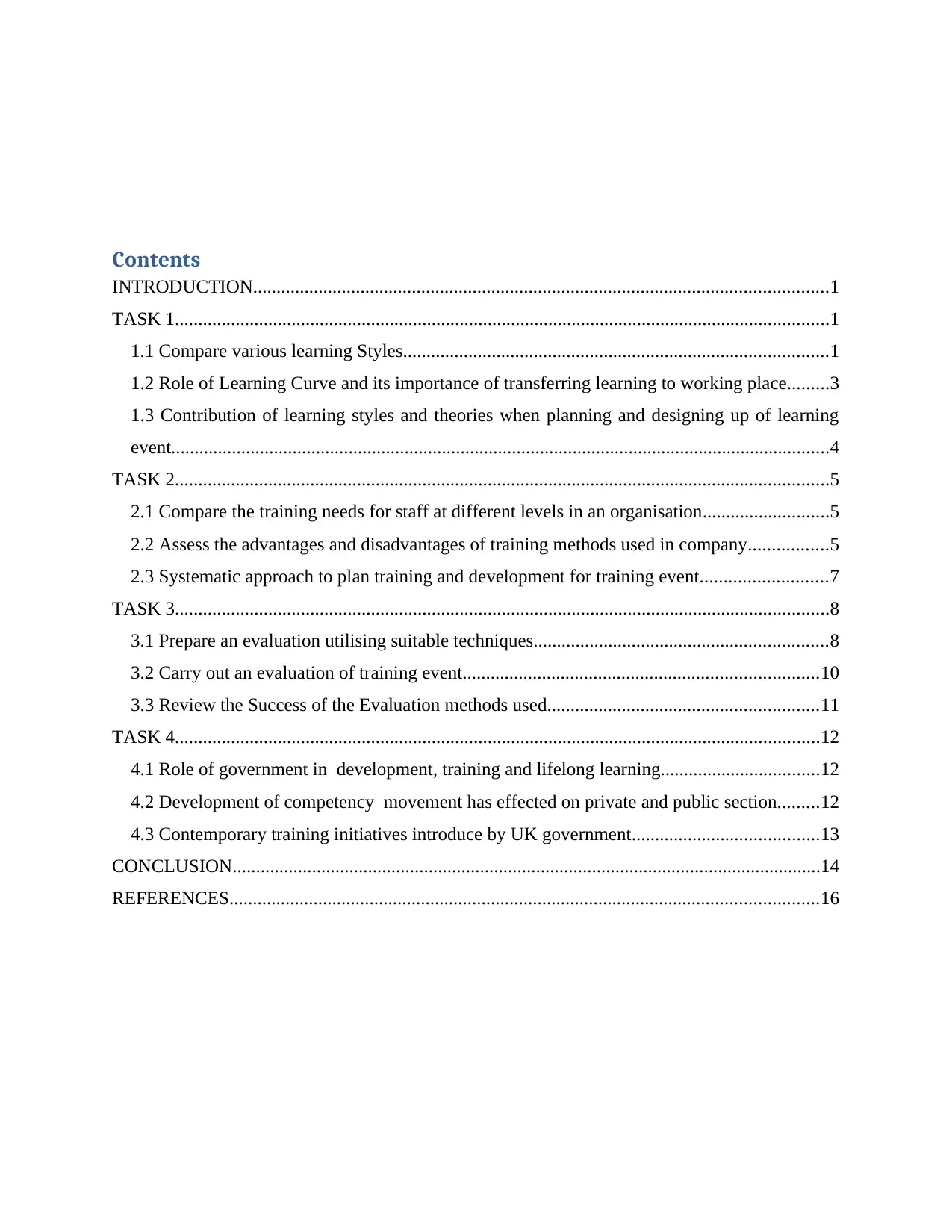
Contents
INTRODUCTION...........................................................................................................................1
TASK 1............................................................................................................................................1
1.1 Compare various learning Styles...........................................................................................1
1.2 Role of Learning Curve and its importance of transferring learning to working place.........3
1.3 Contribution of learning styles and theories when planning and designing up of learning
event.............................................................................................................................................4
TASK 2............................................................................................................................................5
2.1 Compare the training needs for staff at different levels in an organisation...........................5
2.2 Assess the advantages and disadvantages of training methods used in company.................5
2.3 Systematic approach to plan training and development for training event...........................7
TASK 3............................................................................................................................................8
3.1 Prepare an evaluation utilising suitable techniques...............................................................8
3.2 Carry out an evaluation of training event............................................................................10
3.3 Review the Success of the Evaluation methods used..........................................................11
TASK 4..........................................................................................................................................12
4.1 Role of government in development, training and lifelong learning..................................12
4.2 Development of competency movement has effected on private and public section.........12
4.3 Contemporary training initiatives introduce by UK government........................................13
CONCLUSION..............................................................................................................................14
REFERENCES..............................................................................................................................16
INTRODUCTION...........................................................................................................................1
TASK 1............................................................................................................................................1
1.1 Compare various learning Styles...........................................................................................1
1.2 Role of Learning Curve and its importance of transferring learning to working place.........3
1.3 Contribution of learning styles and theories when planning and designing up of learning
event.............................................................................................................................................4
TASK 2............................................................................................................................................5
2.1 Compare the training needs for staff at different levels in an organisation...........................5
2.2 Assess the advantages and disadvantages of training methods used in company.................5
2.3 Systematic approach to plan training and development for training event...........................7
TASK 3............................................................................................................................................8
3.1 Prepare an evaluation utilising suitable techniques...............................................................8
3.2 Carry out an evaluation of training event............................................................................10
3.3 Review the Success of the Evaluation methods used..........................................................11
TASK 4..........................................................................................................................................12
4.1 Role of government in development, training and lifelong learning..................................12
4.2 Development of competency movement has effected on private and public section.........12
4.3 Contemporary training initiatives introduce by UK government........................................13
CONCLUSION..............................................................................................................................14
REFERENCES..............................................................................................................................16

⊘ This is a preview!⊘
Do you want full access?
Subscribe today to unlock all pages.

Trusted by 1+ million students worldwide
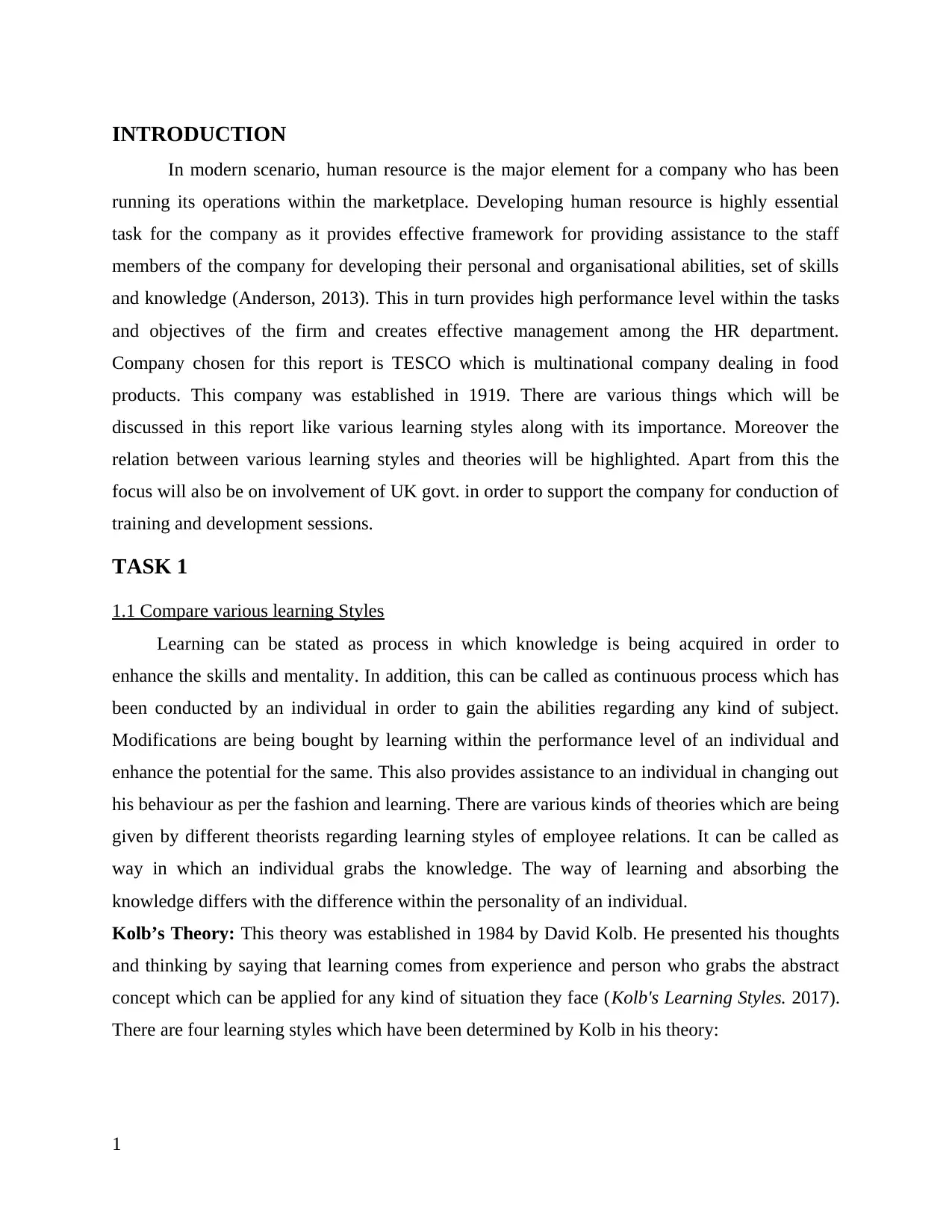
INTRODUCTION
In modern scenario, human resource is the major element for a company who has been
running its operations within the marketplace. Developing human resource is highly essential
task for the company as it provides effective framework for providing assistance to the staff
members of the company for developing their personal and organisational abilities, set of skills
and knowledge (Anderson, 2013). This in turn provides high performance level within the tasks
and objectives of the firm and creates effective management among the HR department.
Company chosen for this report is TESCO which is multinational company dealing in food
products. This company was established in 1919. There are various things which will be
discussed in this report like various learning styles along with its importance. Moreover the
relation between various learning styles and theories will be highlighted. Apart from this the
focus will also be on involvement of UK govt. in order to support the company for conduction of
training and development sessions.
TASK 1
1.1 Compare various learning Styles
Learning can be stated as process in which knowledge is being acquired in order to
enhance the skills and mentality. In addition, this can be called as continuous process which has
been conducted by an individual in order to gain the abilities regarding any kind of subject.
Modifications are being bought by learning within the performance level of an individual and
enhance the potential for the same. This also provides assistance to an individual in changing out
his behaviour as per the fashion and learning. There are various kinds of theories which are being
given by different theorists regarding learning styles of employee relations. It can be called as
way in which an individual grabs the knowledge. The way of learning and absorbing the
knowledge differs with the difference within the personality of an individual.
Kolb’s Theory: This theory was established in 1984 by David Kolb. He presented his thoughts
and thinking by saying that learning comes from experience and person who grabs the abstract
concept which can be applied for any kind of situation they face (Kolb's Learning Styles. 2017).
There are four learning styles which have been determined by Kolb in his theory:
1
In modern scenario, human resource is the major element for a company who has been
running its operations within the marketplace. Developing human resource is highly essential
task for the company as it provides effective framework for providing assistance to the staff
members of the company for developing their personal and organisational abilities, set of skills
and knowledge (Anderson, 2013). This in turn provides high performance level within the tasks
and objectives of the firm and creates effective management among the HR department.
Company chosen for this report is TESCO which is multinational company dealing in food
products. This company was established in 1919. There are various things which will be
discussed in this report like various learning styles along with its importance. Moreover the
relation between various learning styles and theories will be highlighted. Apart from this the
focus will also be on involvement of UK govt. in order to support the company for conduction of
training and development sessions.
TASK 1
1.1 Compare various learning Styles
Learning can be stated as process in which knowledge is being acquired in order to
enhance the skills and mentality. In addition, this can be called as continuous process which has
been conducted by an individual in order to gain the abilities regarding any kind of subject.
Modifications are being bought by learning within the performance level of an individual and
enhance the potential for the same. This also provides assistance to an individual in changing out
his behaviour as per the fashion and learning. There are various kinds of theories which are being
given by different theorists regarding learning styles of employee relations. It can be called as
way in which an individual grabs the knowledge. The way of learning and absorbing the
knowledge differs with the difference within the personality of an individual.
Kolb’s Theory: This theory was established in 1984 by David Kolb. He presented his thoughts
and thinking by saying that learning comes from experience and person who grabs the abstract
concept which can be applied for any kind of situation they face (Kolb's Learning Styles. 2017).
There are four learning styles which have been determined by Kolb in his theory:
1
Paraphrase This Document
Need a fresh take? Get an instant paraphrase of this document with our AI Paraphraser
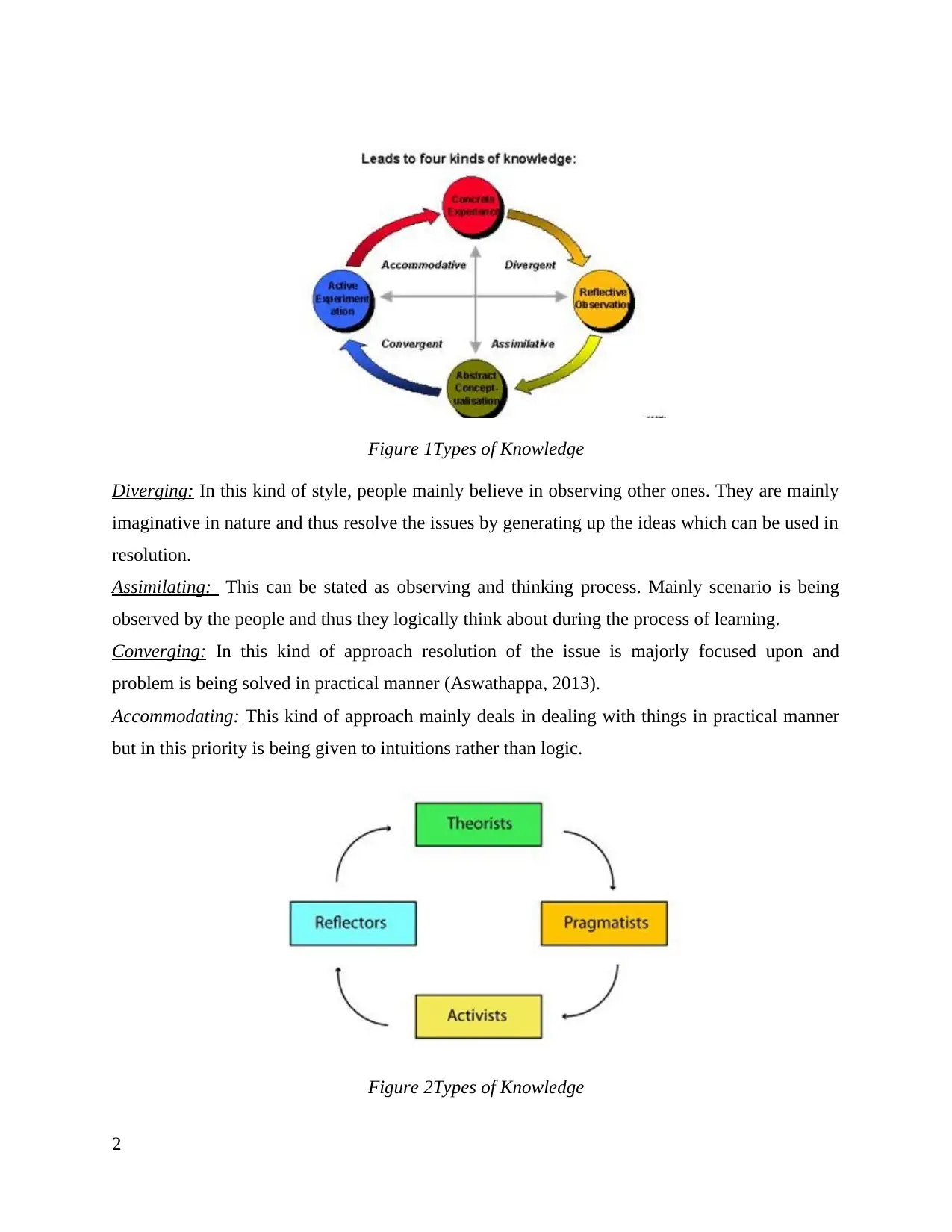
Figure 1Types of Knowledge
Diverging: In this kind of style, people mainly believe in observing other ones. They are mainly
imaginative in nature and thus resolve the issues by generating up the ideas which can be used in
resolution.
Assimilating: This can be stated as observing and thinking process. Mainly scenario is being
observed by the people and thus they logically think about during the process of learning.
Converging: In this kind of approach resolution of the issue is majorly focused upon and
problem is being solved in practical manner (Aswathappa, 2013).
Accommodating: This kind of approach mainly deals in dealing with things in practical manner
but in this priority is being given to intuitions rather than logic.
Figure 2Types of Knowledge
2
Diverging: In this kind of style, people mainly believe in observing other ones. They are mainly
imaginative in nature and thus resolve the issues by generating up the ideas which can be used in
resolution.
Assimilating: This can be stated as observing and thinking process. Mainly scenario is being
observed by the people and thus they logically think about during the process of learning.
Converging: In this kind of approach resolution of the issue is majorly focused upon and
problem is being solved in practical manner (Aswathappa, 2013).
Accommodating: This kind of approach mainly deals in dealing with things in practical manner
but in this priority is being given to intuitions rather than logic.
Figure 2Types of Knowledge
2
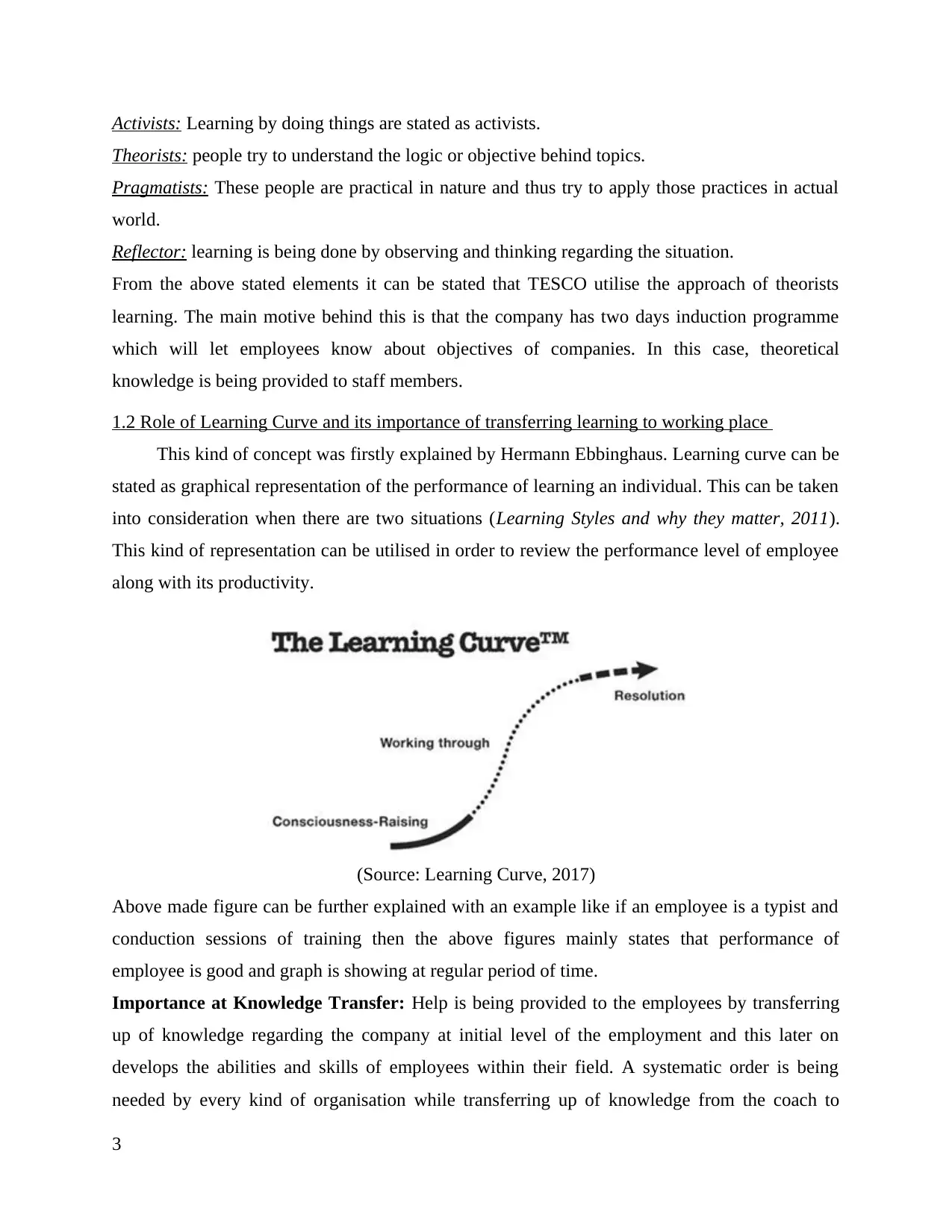
Activists: Learning by doing things are stated as activists.
Theorists: people try to understand the logic or objective behind topics.
Pragmatists: These people are practical in nature and thus try to apply those practices in actual
world.
Reflector: learning is being done by observing and thinking regarding the situation.
From the above stated elements it can be stated that TESCO utilise the approach of theorists
learning. The main motive behind this is that the company has two days induction programme
which will let employees know about objectives of companies. In this case, theoretical
knowledge is being provided to staff members.
1.2 Role of Learning Curve and its importance of transferring learning to working place
This kind of concept was firstly explained by Hermann Ebbinghaus. Learning curve can be
stated as graphical representation of the performance of learning an individual. This can be taken
into consideration when there are two situations (Learning Styles and why they matter, 2011).
This kind of representation can be utilised in order to review the performance level of employee
along with its productivity.
(Source: Learning Curve, 2017)
Above made figure can be further explained with an example like if an employee is a typist and
conduction sessions of training then the above figures mainly states that performance of
employee is good and graph is showing at regular period of time.
Importance at Knowledge Transfer: Help is being provided to the employees by transferring
up of knowledge regarding the company at initial level of the employment and this later on
develops the abilities and skills of employees within their field. A systematic order is being
needed by every kind of organisation while transferring up of knowledge from the coach to
3
Theorists: people try to understand the logic or objective behind topics.
Pragmatists: These people are practical in nature and thus try to apply those practices in actual
world.
Reflector: learning is being done by observing and thinking regarding the situation.
From the above stated elements it can be stated that TESCO utilise the approach of theorists
learning. The main motive behind this is that the company has two days induction programme
which will let employees know about objectives of companies. In this case, theoretical
knowledge is being provided to staff members.
1.2 Role of Learning Curve and its importance of transferring learning to working place
This kind of concept was firstly explained by Hermann Ebbinghaus. Learning curve can be
stated as graphical representation of the performance of learning an individual. This can be taken
into consideration when there are two situations (Learning Styles and why they matter, 2011).
This kind of representation can be utilised in order to review the performance level of employee
along with its productivity.
(Source: Learning Curve, 2017)
Above made figure can be further explained with an example like if an employee is a typist and
conduction sessions of training then the above figures mainly states that performance of
employee is good and graph is showing at regular period of time.
Importance at Knowledge Transfer: Help is being provided to the employees by transferring
up of knowledge regarding the company at initial level of the employment and this later on
develops the abilities and skills of employees within their field. A systematic order is being
needed by every kind of organisation while transferring up of knowledge from the coach to
3
⊘ This is a preview!⊘
Do you want full access?
Subscribe today to unlock all pages.

Trusted by 1+ million students worldwide
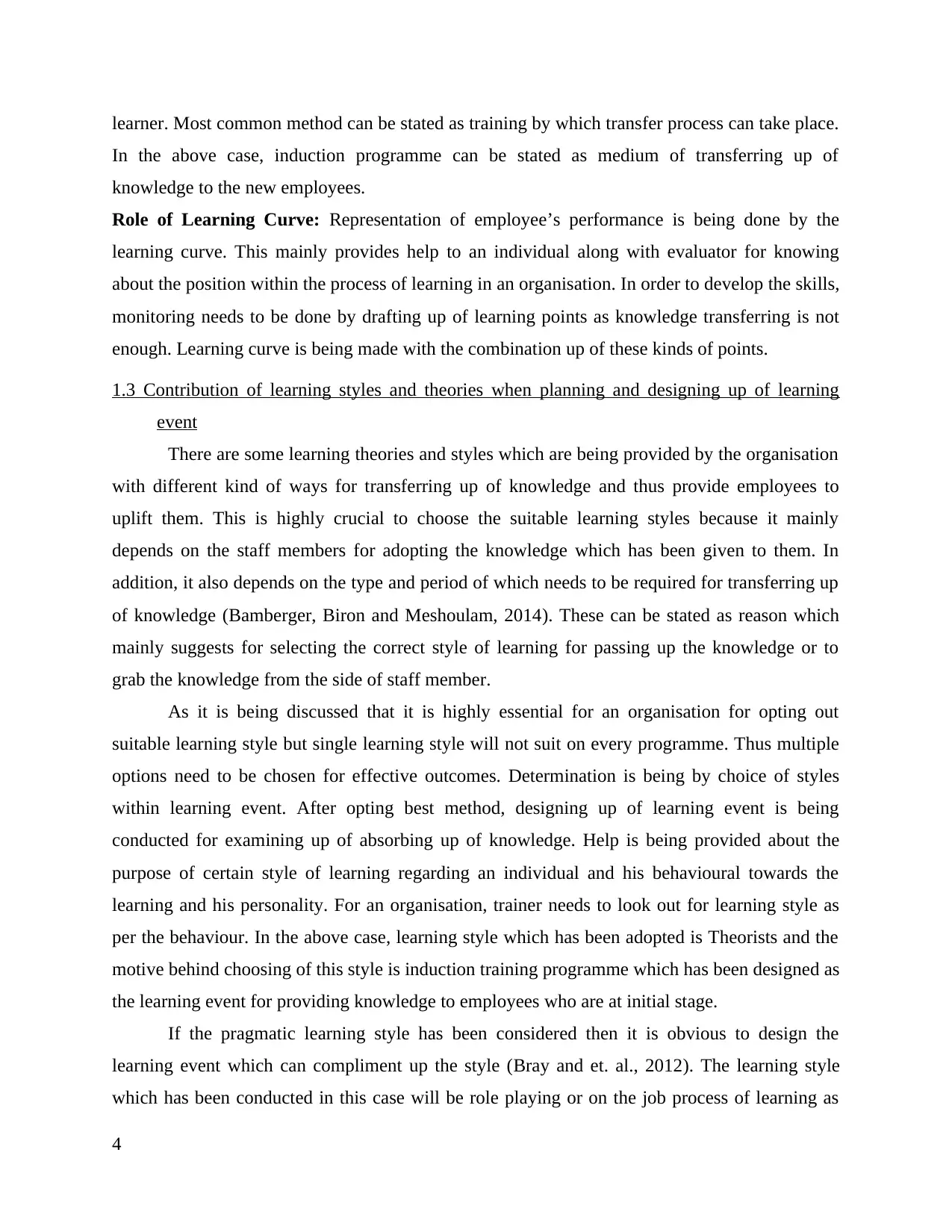
learner. Most common method can be stated as training by which transfer process can take place.
In the above case, induction programme can be stated as medium of transferring up of
knowledge to the new employees.
Role of Learning Curve: Representation of employee’s performance is being done by the
learning curve. This mainly provides help to an individual along with evaluator for knowing
about the position within the process of learning in an organisation. In order to develop the skills,
monitoring needs to be done by drafting up of learning points as knowledge transferring is not
enough. Learning curve is being made with the combination up of these kinds of points.
1.3 Contribution of learning styles and theories when planning and designing up of learning
event
There are some learning theories and styles which are being provided by the organisation
with different kind of ways for transferring up of knowledge and thus provide employees to
uplift them. This is highly crucial to choose the suitable learning styles because it mainly
depends on the staff members for adopting the knowledge which has been given to them. In
addition, it also depends on the type and period of which needs to be required for transferring up
of knowledge (Bamberger, Biron and Meshoulam, 2014). These can be stated as reason which
mainly suggests for selecting the correct style of learning for passing up the knowledge or to
grab the knowledge from the side of staff member.
As it is being discussed that it is highly essential for an organisation for opting out
suitable learning style but single learning style will not suit on every programme. Thus multiple
options need to be chosen for effective outcomes. Determination is being by choice of styles
within learning event. After opting best method, designing up of learning event is being
conducted for examining up of absorbing up of knowledge. Help is being provided about the
purpose of certain style of learning regarding an individual and his behavioural towards the
learning and his personality. For an organisation, trainer needs to look out for learning style as
per the behaviour. In the above case, learning style which has been adopted is Theorists and the
motive behind choosing of this style is induction training programme which has been designed as
the learning event for providing knowledge to employees who are at initial stage.
If the pragmatic learning style has been considered then it is obvious to design the
learning event which can compliment up the style (Bray and et. al., 2012). The learning style
which has been conducted in this case will be role playing or on the job process of learning as
4
In the above case, induction programme can be stated as medium of transferring up of
knowledge to the new employees.
Role of Learning Curve: Representation of employee’s performance is being done by the
learning curve. This mainly provides help to an individual along with evaluator for knowing
about the position within the process of learning in an organisation. In order to develop the skills,
monitoring needs to be done by drafting up of learning points as knowledge transferring is not
enough. Learning curve is being made with the combination up of these kinds of points.
1.3 Contribution of learning styles and theories when planning and designing up of learning
event
There are some learning theories and styles which are being provided by the organisation
with different kind of ways for transferring up of knowledge and thus provide employees to
uplift them. This is highly crucial to choose the suitable learning styles because it mainly
depends on the staff members for adopting the knowledge which has been given to them. In
addition, it also depends on the type and period of which needs to be required for transferring up
of knowledge (Bamberger, Biron and Meshoulam, 2014). These can be stated as reason which
mainly suggests for selecting the correct style of learning for passing up the knowledge or to
grab the knowledge from the side of staff member.
As it is being discussed that it is highly essential for an organisation for opting out
suitable learning style but single learning style will not suit on every programme. Thus multiple
options need to be chosen for effective outcomes. Determination is being by choice of styles
within learning event. After opting best method, designing up of learning event is being
conducted for examining up of absorbing up of knowledge. Help is being provided about the
purpose of certain style of learning regarding an individual and his behavioural towards the
learning and his personality. For an organisation, trainer needs to look out for learning style as
per the behaviour. In the above case, learning style which has been adopted is Theorists and the
motive behind choosing of this style is induction training programme which has been designed as
the learning event for providing knowledge to employees who are at initial stage.
If the pragmatic learning style has been considered then it is obvious to design the
learning event which can compliment up the style (Bray and et. al., 2012). The learning style
which has been conducted in this case will be role playing or on the job process of learning as
4
Paraphrase This Document
Need a fresh take? Get an instant paraphrase of this document with our AI Paraphraser
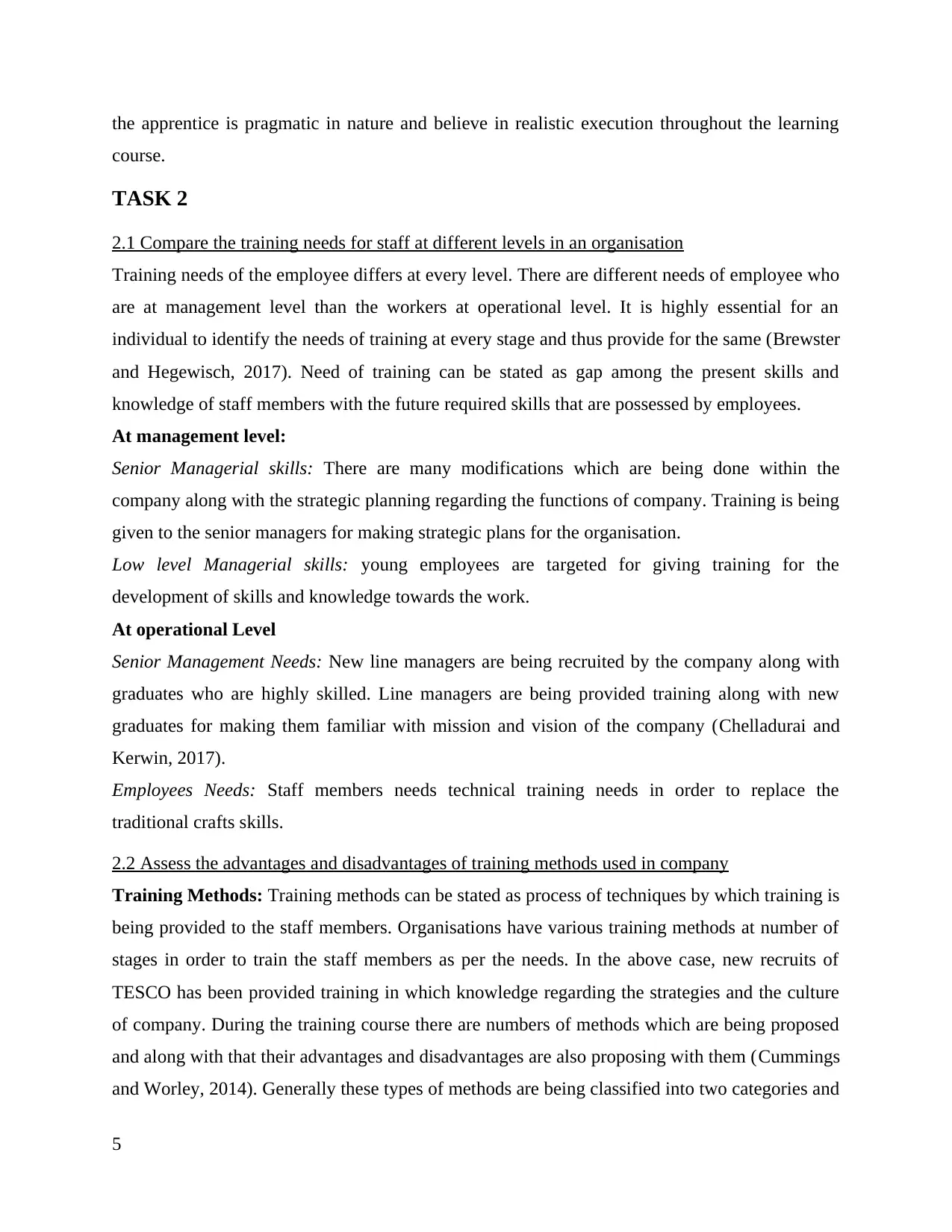
the apprentice is pragmatic in nature and believe in realistic execution throughout the learning
course.
TASK 2
2.1 Compare the training needs for staff at different levels in an organisation
Training needs of the employee differs at every level. There are different needs of employee who
are at management level than the workers at operational level. It is highly essential for an
individual to identify the needs of training at every stage and thus provide for the same (Brewster
and Hegewisch, 2017). Need of training can be stated as gap among the present skills and
knowledge of staff members with the future required skills that are possessed by employees.
At management level:
Senior Managerial skills: There are many modifications which are being done within the
company along with the strategic planning regarding the functions of company. Training is being
given to the senior managers for making strategic plans for the organisation.
Low level Managerial skills: young employees are targeted for giving training for the
development of skills and knowledge towards the work.
At operational Level
Senior Management Needs: New line managers are being recruited by the company along with
graduates who are highly skilled. Line managers are being provided training along with new
graduates for making them familiar with mission and vision of the company (Chelladurai and
Kerwin, 2017).
Employees Needs: Staff members needs technical training needs in order to replace the
traditional crafts skills.
2.2 Assess the advantages and disadvantages of training methods used in company
Training Methods: Training methods can be stated as process of techniques by which training is
being provided to the staff members. Organisations have various training methods at number of
stages in order to train the staff members as per the needs. In the above case, new recruits of
TESCO has been provided training in which knowledge regarding the strategies and the culture
of company. During the training course there are numbers of methods which are being proposed
and along with that their advantages and disadvantages are also proposing with them (Cummings
and Worley, 2014). Generally these types of methods are being classified into two categories and
5
course.
TASK 2
2.1 Compare the training needs for staff at different levels in an organisation
Training needs of the employee differs at every level. There are different needs of employee who
are at management level than the workers at operational level. It is highly essential for an
individual to identify the needs of training at every stage and thus provide for the same (Brewster
and Hegewisch, 2017). Need of training can be stated as gap among the present skills and
knowledge of staff members with the future required skills that are possessed by employees.
At management level:
Senior Managerial skills: There are many modifications which are being done within the
company along with the strategic planning regarding the functions of company. Training is being
given to the senior managers for making strategic plans for the organisation.
Low level Managerial skills: young employees are targeted for giving training for the
development of skills and knowledge towards the work.
At operational Level
Senior Management Needs: New line managers are being recruited by the company along with
graduates who are highly skilled. Line managers are being provided training along with new
graduates for making them familiar with mission and vision of the company (Chelladurai and
Kerwin, 2017).
Employees Needs: Staff members needs technical training needs in order to replace the
traditional crafts skills.
2.2 Assess the advantages and disadvantages of training methods used in company
Training Methods: Training methods can be stated as process of techniques by which training is
being provided to the staff members. Organisations have various training methods at number of
stages in order to train the staff members as per the needs. In the above case, new recruits of
TESCO has been provided training in which knowledge regarding the strategies and the culture
of company. During the training course there are numbers of methods which are being proposed
and along with that their advantages and disadvantages are also proposing with them (Cummings
and Worley, 2014). Generally these types of methods are being classified into two categories and
5
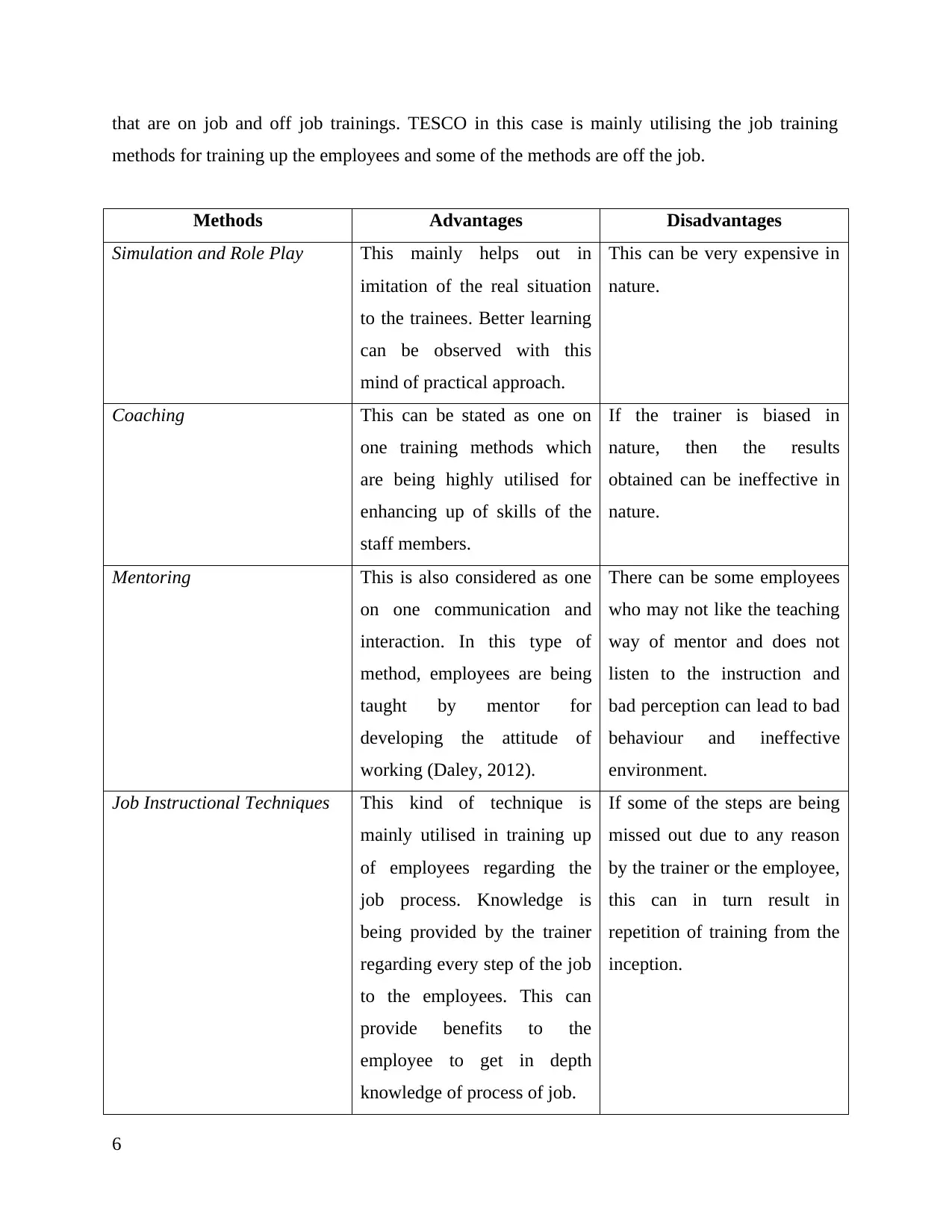
that are on job and off job trainings. TESCO in this case is mainly utilising the job training
methods for training up the employees and some of the methods are off the job.
Methods Advantages Disadvantages
Simulation and Role Play This mainly helps out in
imitation of the real situation
to the trainees. Better learning
can be observed with this
mind of practical approach.
This can be very expensive in
nature.
Coaching This can be stated as one on
one training methods which
are being highly utilised for
enhancing up of skills of the
staff members.
If the trainer is biased in
nature, then the results
obtained can be ineffective in
nature.
Mentoring This is also considered as one
on one communication and
interaction. In this type of
method, employees are being
taught by mentor for
developing the attitude of
working (Daley, 2012).
There can be some employees
who may not like the teaching
way of mentor and does not
listen to the instruction and
bad perception can lead to bad
behaviour and ineffective
environment.
Job Instructional Techniques This kind of technique is
mainly utilised in training up
of employees regarding the
job process. Knowledge is
being provided by the trainer
regarding every step of the job
to the employees. This can
provide benefits to the
employee to get in depth
knowledge of process of job.
If some of the steps are being
missed out due to any reason
by the trainer or the employee,
this can in turn result in
repetition of training from the
inception.
6
methods for training up the employees and some of the methods are off the job.
Methods Advantages Disadvantages
Simulation and Role Play This mainly helps out in
imitation of the real situation
to the trainees. Better learning
can be observed with this
mind of practical approach.
This can be very expensive in
nature.
Coaching This can be stated as one on
one training methods which
are being highly utilised for
enhancing up of skills of the
staff members.
If the trainer is biased in
nature, then the results
obtained can be ineffective in
nature.
Mentoring This is also considered as one
on one communication and
interaction. In this type of
method, employees are being
taught by mentor for
developing the attitude of
working (Daley, 2012).
There can be some employees
who may not like the teaching
way of mentor and does not
listen to the instruction and
bad perception can lead to bad
behaviour and ineffective
environment.
Job Instructional Techniques This kind of technique is
mainly utilised in training up
of employees regarding the
job process. Knowledge is
being provided by the trainer
regarding every step of the job
to the employees. This can
provide benefits to the
employee to get in depth
knowledge of process of job.
If some of the steps are being
missed out due to any reason
by the trainer or the employee,
this can in turn result in
repetition of training from the
inception.
6
⊘ This is a preview!⊘
Do you want full access?
Subscribe today to unlock all pages.

Trusted by 1+ million students worldwide
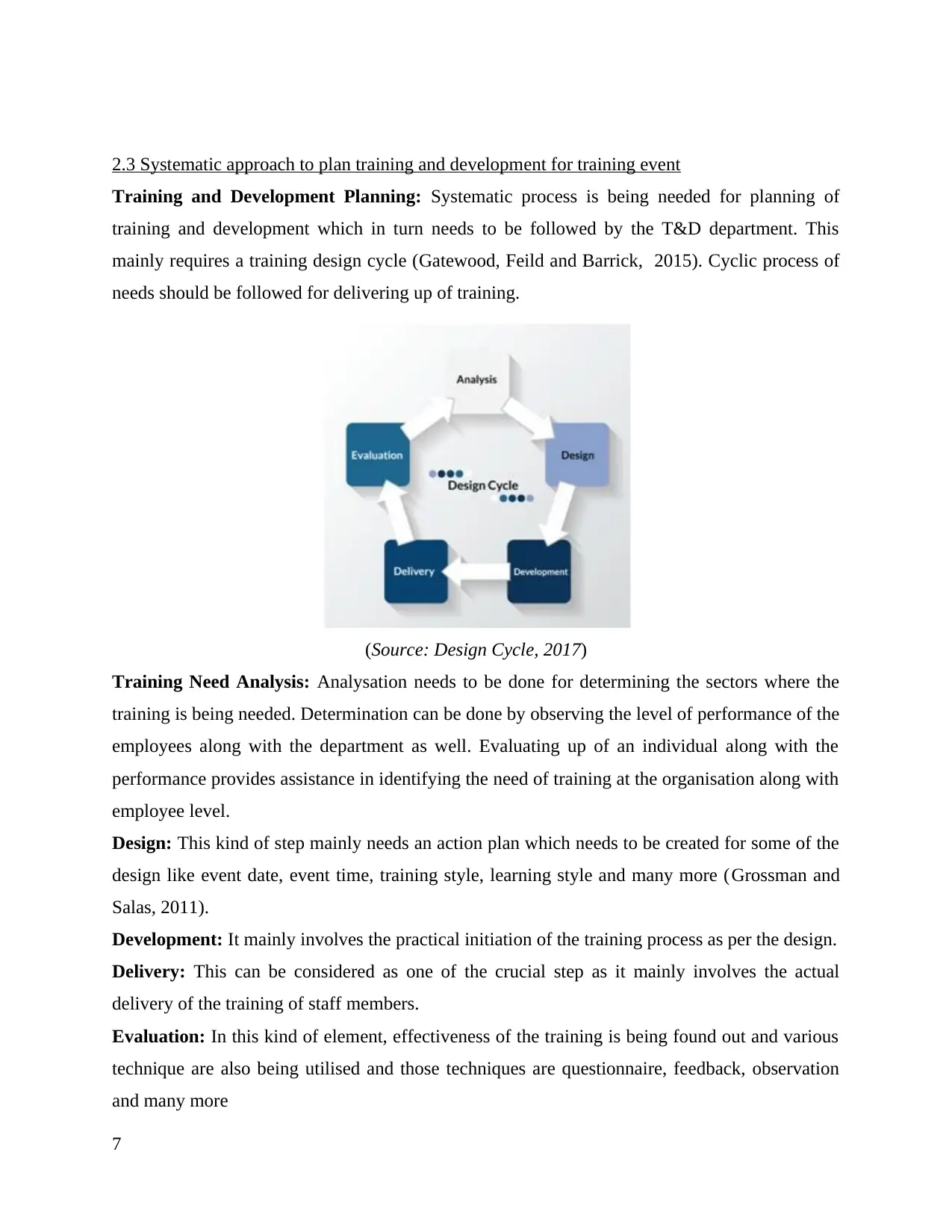
2.3 Systematic approach to plan training and development for training event
Training and Development Planning: Systematic process is being needed for planning of
training and development which in turn needs to be followed by the T&D department. This
mainly requires a training design cycle (Gatewood, Feild and Barrick, 2015). Cyclic process of
needs should be followed for delivering up of training.
(Source: Design Cycle, 2017)
Training Need Analysis: Analysation needs to be done for determining the sectors where the
training is being needed. Determination can be done by observing the level of performance of the
employees along with the department as well. Evaluating up of an individual along with the
performance provides assistance in identifying the need of training at the organisation along with
employee level.
Design: This kind of step mainly needs an action plan which needs to be created for some of the
design like event date, event time, training style, learning style and many more (Grossman and
Salas, 2011).
Development: It mainly involves the practical initiation of the training process as per the design.
Delivery: This can be considered as one of the crucial step as it mainly involves the actual
delivery of the training of staff members.
Evaluation: In this kind of element, effectiveness of the training is being found out and various
technique are also being utilised and those techniques are questionnaire, feedback, observation
and many more
7
Training and Development Planning: Systematic process is being needed for planning of
training and development which in turn needs to be followed by the T&D department. This
mainly requires a training design cycle (Gatewood, Feild and Barrick, 2015). Cyclic process of
needs should be followed for delivering up of training.
(Source: Design Cycle, 2017)
Training Need Analysis: Analysation needs to be done for determining the sectors where the
training is being needed. Determination can be done by observing the level of performance of the
employees along with the department as well. Evaluating up of an individual along with the
performance provides assistance in identifying the need of training at the organisation along with
employee level.
Design: This kind of step mainly needs an action plan which needs to be created for some of the
design like event date, event time, training style, learning style and many more (Grossman and
Salas, 2011).
Development: It mainly involves the practical initiation of the training process as per the design.
Delivery: This can be considered as one of the crucial step as it mainly involves the actual
delivery of the training of staff members.
Evaluation: In this kind of element, effectiveness of the training is being found out and various
technique are also being utilised and those techniques are questionnaire, feedback, observation
and many more
7
Paraphrase This Document
Need a fresh take? Get an instant paraphrase of this document with our AI Paraphraser
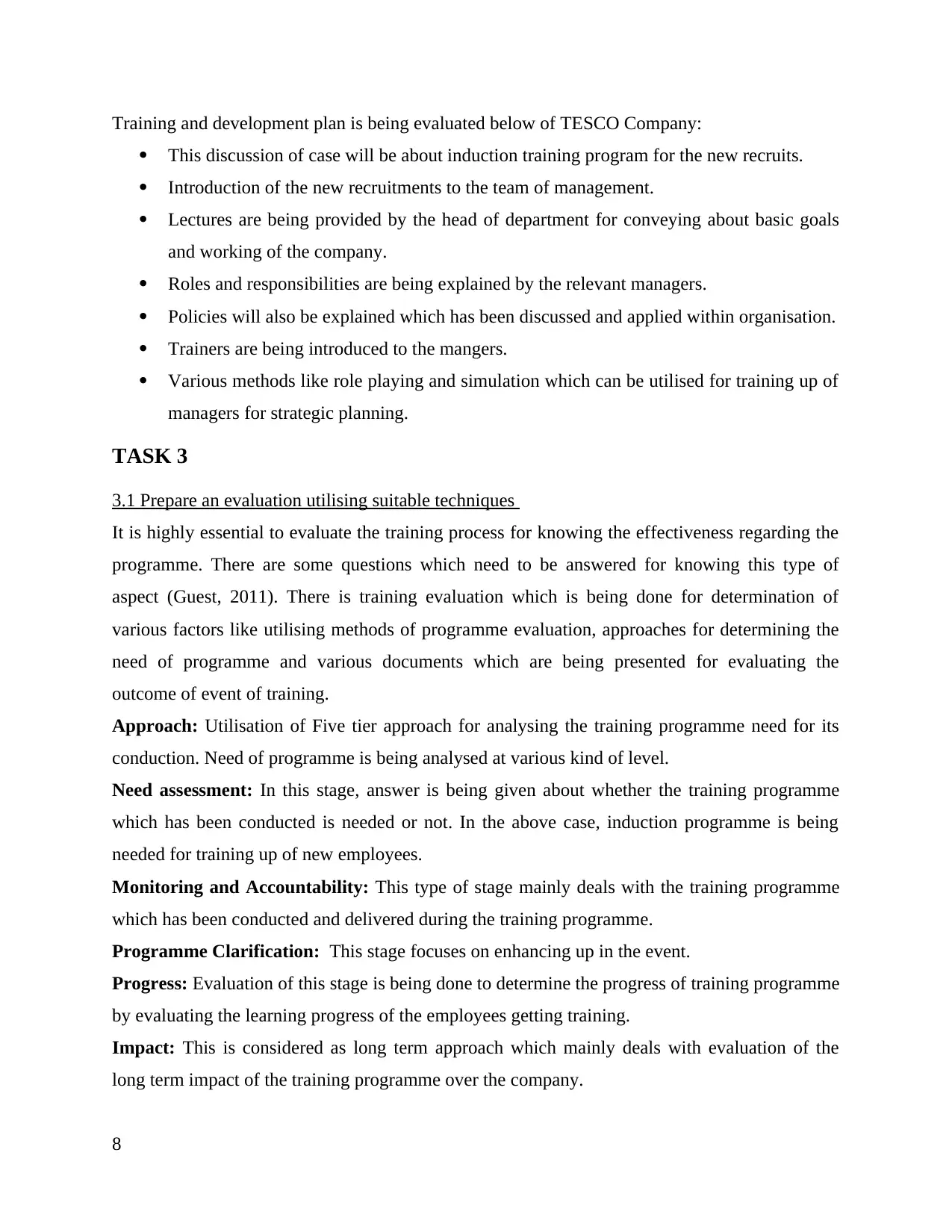
Training and development plan is being evaluated below of TESCO Company:
This discussion of case will be about induction training program for the new recruits.
Introduction of the new recruitments to the team of management.
Lectures are being provided by the head of department for conveying about basic goals
and working of the company.
Roles and responsibilities are being explained by the relevant managers.
Policies will also be explained which has been discussed and applied within organisation.
Trainers are being introduced to the mangers.
Various methods like role playing and simulation which can be utilised for training up of
managers for strategic planning.
TASK 3
3.1 Prepare an evaluation utilising suitable techniques
It is highly essential to evaluate the training process for knowing the effectiveness regarding the
programme. There are some questions which need to be answered for knowing this type of
aspect (Guest, 2011). There is training evaluation which is being done for determination of
various factors like utilising methods of programme evaluation, approaches for determining the
need of programme and various documents which are being presented for evaluating the
outcome of event of training.
Approach: Utilisation of Five tier approach for analysing the training programme need for its
conduction. Need of programme is being analysed at various kind of level.
Need assessment: In this stage, answer is being given about whether the training programme
which has been conducted is needed or not. In the above case, induction programme is being
needed for training up of new employees.
Monitoring and Accountability: This type of stage mainly deals with the training programme
which has been conducted and delivered during the training programme.
Programme Clarification: This stage focuses on enhancing up in the event.
Progress: Evaluation of this stage is being done to determine the progress of training programme
by evaluating the learning progress of the employees getting training.
Impact: This is considered as long term approach which mainly deals with evaluation of the
long term impact of the training programme over the company.
8
This discussion of case will be about induction training program for the new recruits.
Introduction of the new recruitments to the team of management.
Lectures are being provided by the head of department for conveying about basic goals
and working of the company.
Roles and responsibilities are being explained by the relevant managers.
Policies will also be explained which has been discussed and applied within organisation.
Trainers are being introduced to the mangers.
Various methods like role playing and simulation which can be utilised for training up of
managers for strategic planning.
TASK 3
3.1 Prepare an evaluation utilising suitable techniques
It is highly essential to evaluate the training process for knowing the effectiveness regarding the
programme. There are some questions which need to be answered for knowing this type of
aspect (Guest, 2011). There is training evaluation which is being done for determination of
various factors like utilising methods of programme evaluation, approaches for determining the
need of programme and various documents which are being presented for evaluating the
outcome of event of training.
Approach: Utilisation of Five tier approach for analysing the training programme need for its
conduction. Need of programme is being analysed at various kind of level.
Need assessment: In this stage, answer is being given about whether the training programme
which has been conducted is needed or not. In the above case, induction programme is being
needed for training up of new employees.
Monitoring and Accountability: This type of stage mainly deals with the training programme
which has been conducted and delivered during the training programme.
Programme Clarification: This stage focuses on enhancing up in the event.
Progress: Evaluation of this stage is being done to determine the progress of training programme
by evaluating the learning progress of the employees getting training.
Impact: This is considered as long term approach which mainly deals with evaluation of the
long term impact of the training programme over the company.
8
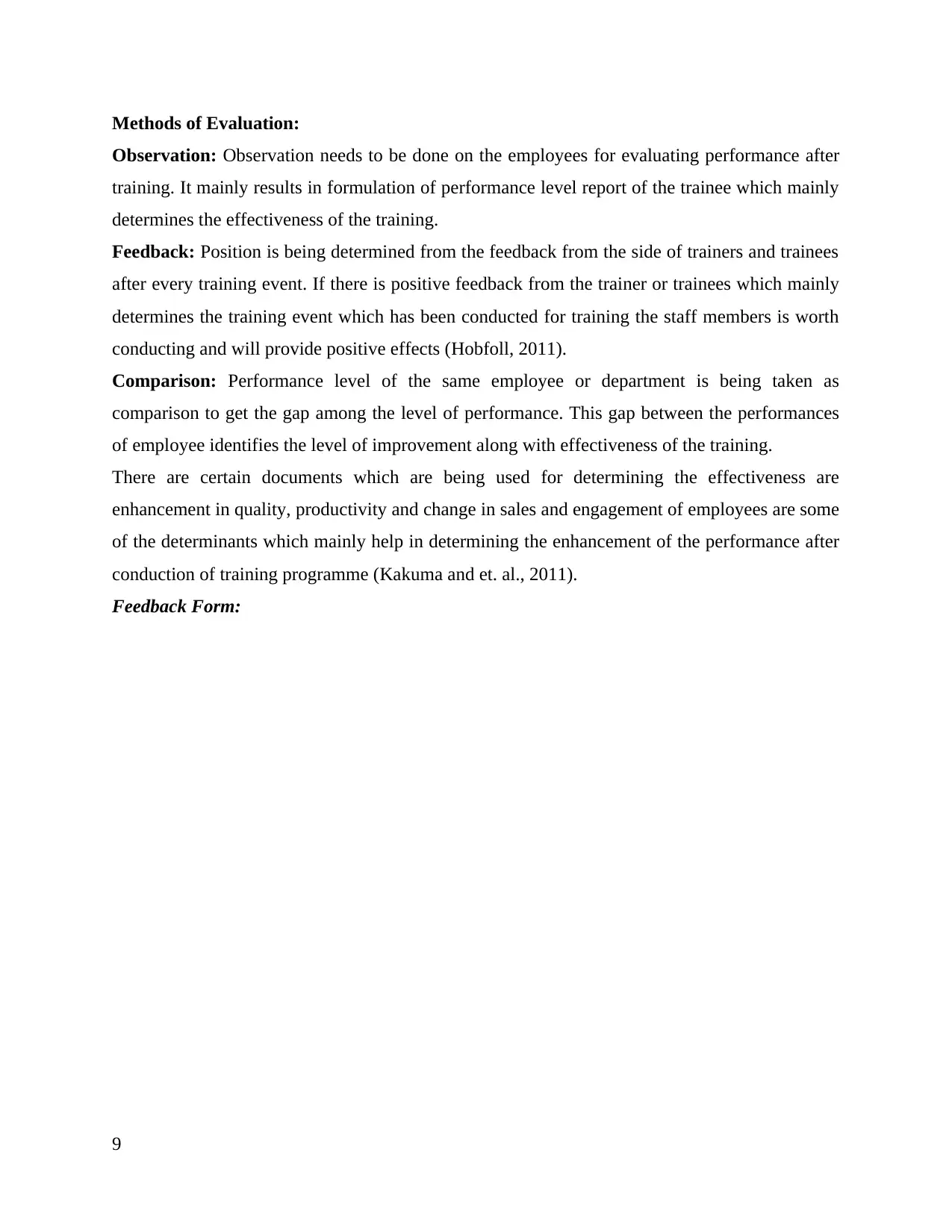
Methods of Evaluation:
Observation: Observation needs to be done on the employees for evaluating performance after
training. It mainly results in formulation of performance level report of the trainee which mainly
determines the effectiveness of the training.
Feedback: Position is being determined from the feedback from the side of trainers and trainees
after every training event. If there is positive feedback from the trainer or trainees which mainly
determines the training event which has been conducted for training the staff members is worth
conducting and will provide positive effects (Hobfoll, 2011).
Comparison: Performance level of the same employee or department is being taken as
comparison to get the gap among the level of performance. This gap between the performances
of employee identifies the level of improvement along with effectiveness of the training.
There are certain documents which are being used for determining the effectiveness are
enhancement in quality, productivity and change in sales and engagement of employees are some
of the determinants which mainly help in determining the enhancement of the performance after
conduction of training programme (Kakuma and et. al., 2011).
Feedback Form:
9
Observation: Observation needs to be done on the employees for evaluating performance after
training. It mainly results in formulation of performance level report of the trainee which mainly
determines the effectiveness of the training.
Feedback: Position is being determined from the feedback from the side of trainers and trainees
after every training event. If there is positive feedback from the trainer or trainees which mainly
determines the training event which has been conducted for training the staff members is worth
conducting and will provide positive effects (Hobfoll, 2011).
Comparison: Performance level of the same employee or department is being taken as
comparison to get the gap among the level of performance. This gap between the performances
of employee identifies the level of improvement along with effectiveness of the training.
There are certain documents which are being used for determining the effectiveness are
enhancement in quality, productivity and change in sales and engagement of employees are some
of the determinants which mainly help in determining the enhancement of the performance after
conduction of training programme (Kakuma and et. al., 2011).
Feedback Form:
9
⊘ This is a preview!⊘
Do you want full access?
Subscribe today to unlock all pages.

Trusted by 1+ million students worldwide
1 out of 19
Related Documents
Your All-in-One AI-Powered Toolkit for Academic Success.
+13062052269
info@desklib.com
Available 24*7 on WhatsApp / Email
![[object Object]](/_next/static/media/star-bottom.7253800d.svg)
Unlock your academic potential
Copyright © 2020–2025 A2Z Services. All Rights Reserved. Developed and managed by ZUCOL.





